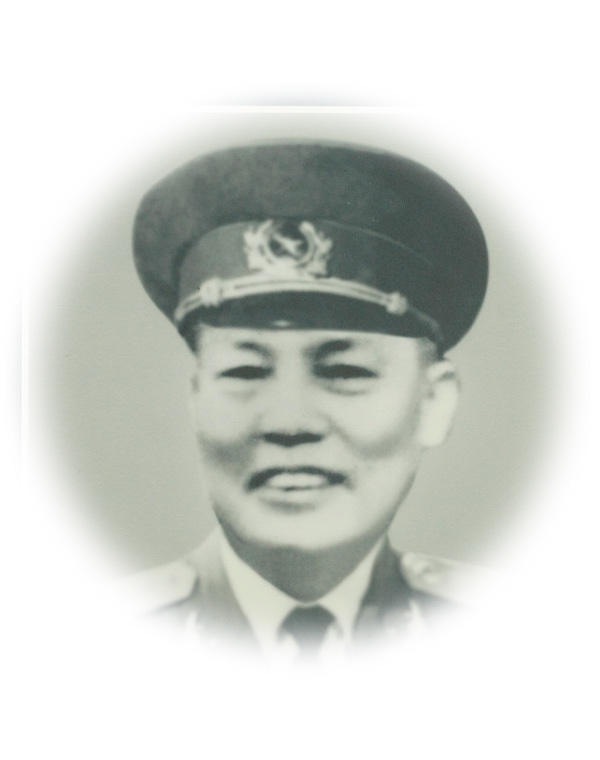


-Proper name: Phan Đình Dinh
- Native place: Nam Vân commune, Nam Định city, Nam
Định province
- Positions: Standing officer of the military commission of the
party central committee, Chairman of the Head Department
of Logistics, Deputy Commander of the Hồ Chí Minh
campaign
As the Chairman of the Head Department of Logistics during
the war against the US, he was assigned to organize and
upgrade the North - South strategic supply line (Trường Sơn
Trail), build a system of petroleum pipelines and information
system from North to South.


Born in a poor Confucian family, his father died early, he and his brother, comrade Lê Đức Thọ, participated in revolutionary activities at a young age (1930). He was imprisoned by the French twice (1930 and 1940), but after being released, he continued to actively participate in revolutionary activities.
Photo: Brothers, Comrade Lê Đức Thọ (Phan Đình Khải) and Đinh Đức Thiện (Phan Đình Dinh)
SHOW
In 1954, he held the position of Deputy Head of the General Department of Army ordnance under the Vietnam People's Army, and was in charge of Army ordnance protection and food preparation for the Điện Biên Phủ campaign.
Tens of thousands of bicycles, buffalo-drawn carts, ox-drawn carts, horse-drawn carts and boats were used to
transport tens of thousands of tons of rice, food, and weapons to the fronts in Điện Biên Phủ, 1953 - 1954
Source: VNA

In 1965, he held the position of Head of the General Department of Army ordnance, Member of the Military Commission of the Party Central Committee, who was responsible for transporting supplies for the Southern revolution. He was one of the people who made important contributions to the construction of the legendary Hồ Chí Minh Trail (codename 559), especially in the petroleum pipeline system from North to South which is more than 5,000km long. They are considered as "miracles of our Vietnamese army in the resistance war against the US".
Photo: Comrade Đinh Đức Thiện (left) gave encouragement to the Army Corps 559 in 1971
SHOW
Comrade Đinh Đức Thiện talked with General Võ Nguyên Giáp about Army ordnance in the resistance war against the US
SHOW
Comrade Đinh Đức Thiện received General Võ Nguyên Giáp on his visit to the General Department of Army ordnance.
SHOW
The story of "Rice bag with four layers":
"Rice of soldiers in the Southern battlefields was mostly transported from the North. From the rice warehouses
in the rear, rice had to go through the transport route 559, then was transported in papooses and bicycles of
units to the battlefields. On the way, it might get wet by rain. When rice was transported to the battlefield,
it was not immediately used, but had to be stored for a long time. when rice came to soldiers, most of it was
of poor quality: moldy or eaten by parasites. However, soldiers still had to eat the low-quality rice because
there was no other choice. That is why soldiers often suffered from diseases that made them feel numb and edematous.
Even in some units, the disease developed like an epidemic. Comrade Đinh Đức Thiện asked the Military Food and
Clothing Research Institute to study how to pack rice so that it could be preserved for at least one year.
Rice bags with four layers were born in that situation. Four layers of bags include: the innermost layer is jute,
the second layer is polyethylene, the third layer is PVC to prevent moisture and water, the outermost is a flax bag.
Rice stored in this kind of bag could be kept for 2-3 years.

On a visit to the Provincial Party Committee in Quảng Bình province, Comrade Đinh Đức Thiện (5th person from the right) reported to General Võ Nguyên Giáp the results of reinforcements on the Southern battlefield, 1969.
SHOW
Although he always had a lot of work to do, when he was assigned to be Head of the General Department of Army ordnance, Mr. Đinh Đức Thiện still advised Secretary Trần Lư to try to take the time to have fieldtrips: “Prioritize What needs to be done first, stay away from your office, family and Hanoi; get to bases to observe and research to solve problems properly."
Photo: Comrade Đinh Đức Thiện and other comrades at the Trail 9 - Southern Laos front, 1970
SHOW
Major General Đinh Đức Thiện (middle) Head of the General Department of Army ordnance had a photo taken with the Commander and Political Commissar of Trường Sơn Command before he personally directed the Central Highlands campaign and the Hồ Chí Minh campaign.
SHOW
Major General Đinh Đức Thiện and General Văn Tiến Dũng during the Central Highlands campaign, 1975
SHOW
Major General Đinh Đức Thiện and General Văn Tiến Dũng during the Central Highlands campaign, 1975
SHOW
Comrade Đinh Đức Thiện and comrades: Trần Văn Trà, Lê Đức Thọ, Văn Tiến Dũng, Phạm Hùng at the Hồ Chí Minh Campaign Command after liberation day
SHOW
Comrade Đinh Đức Thiện attended the Army Corps meeting after the liberation of Saigon, May 4, 1975
SHOW
In 1975, he was assigned by the Government to take over the facilities and documents of oil and gas companies in the South, and at the same time to establish the General Department of Oil and Gas. He was clear-sighted, so he understood very well the importance of oil and gas for the country's economic development and he also laid an important foundation for oil exploration and exploitation plans later.
Source: Minister Đinh Đức Thiện visited Vũng Tàu before deciding to set up a base for synthetic oil and gas services
SHOW
General Đinh Đức Thiện (middle), oil and gas consultant G. A. Kostromin (wearing sunglasses) and Vietnamese experts visited the Cửu Long1 oil well in the Mekong Delta
Photo: Petrovietnam Tradition Room
SHOW